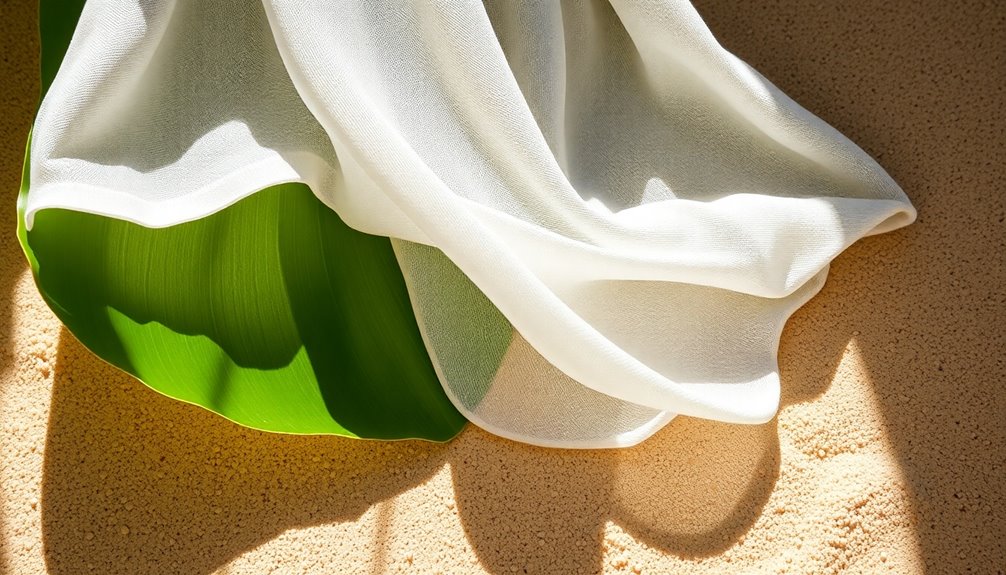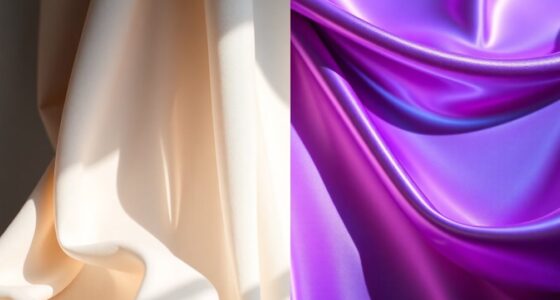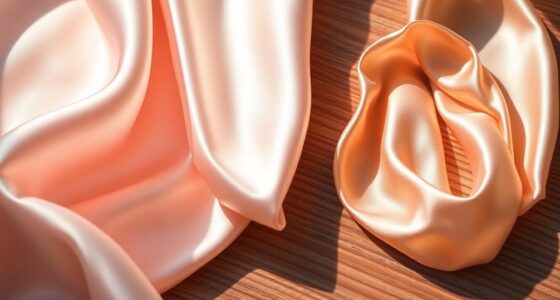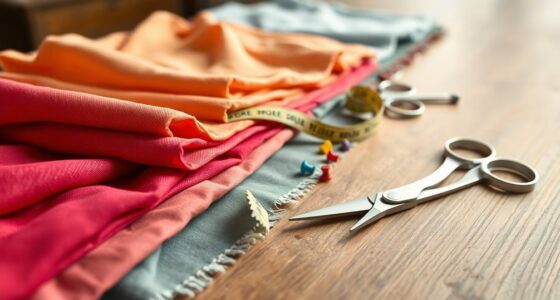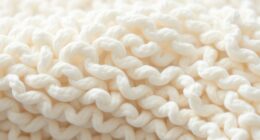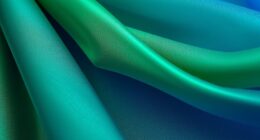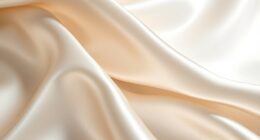When weighing Lyocell against cotton, you'll find Lyocell is the better option for both your skin and the planet. It's hypoallergenic, moisture-wicking, and biodegradable, making it gentle on sensitive skin and environmentally friendly. Cotton can be comfortable, but it's often more water-intensive and uses harmful chemicals in production. If you're looking for a luxurious feel and sustainable choice, Lyocell is your best bet. Discover more about their differences and how they impact your lifestyle.
Key Takeaways
- Lyocell is more eco-friendly, using a closed-loop system that recycles 99% of chemicals and water in its production process.
- Cotton, especially conventional, requires significant water and pesticides, harming the environment and ecosystems.
- Lyocell is hypoallergenic and excels in moisture management, making it ideal for sensitive skin and reducing odor retention.
- While high-quality cotton can be durable, Lyocell typically outperforms it in longevity and maintains softness without pilling.
- Choosing Lyocell supports sustainability and comfort, while cotton may be budget-friendly but less eco-conscious and consistent in quality.
What Is Lyocell Fabric?
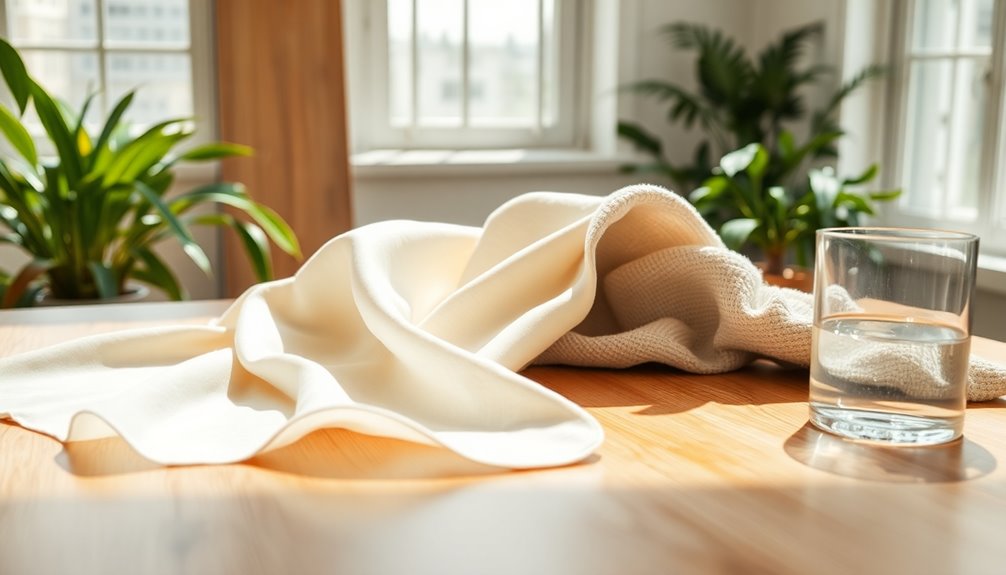
Lyocell fabric, often hailed for its eco-friendliness, is a semi-synthetic fiber crafted from wood pulp, mainly sourced from eucalyptus trees.
This sustainable material stands out due to its eco-friendly production process, which employs a closed-loop system that recycles 99.5% of chemicals, minimizing waste.
Lyocell isn't only biodegradable but also compostable, making it a great choice for environmentally conscious consumers.
Its smooth texture and excellent moisture-wicking properties enhance breathability, making it ideal for sensitive skin.
As the global market for Lyocell reached $1.1 billion in 2021, it's clear that more people are recognizing the benefits of this natural fiber over traditional synthetics.
Choosing Lyocell means opting for comfort, sustainability, and a reduced environmental impact.
What Is Cotton Fabric?
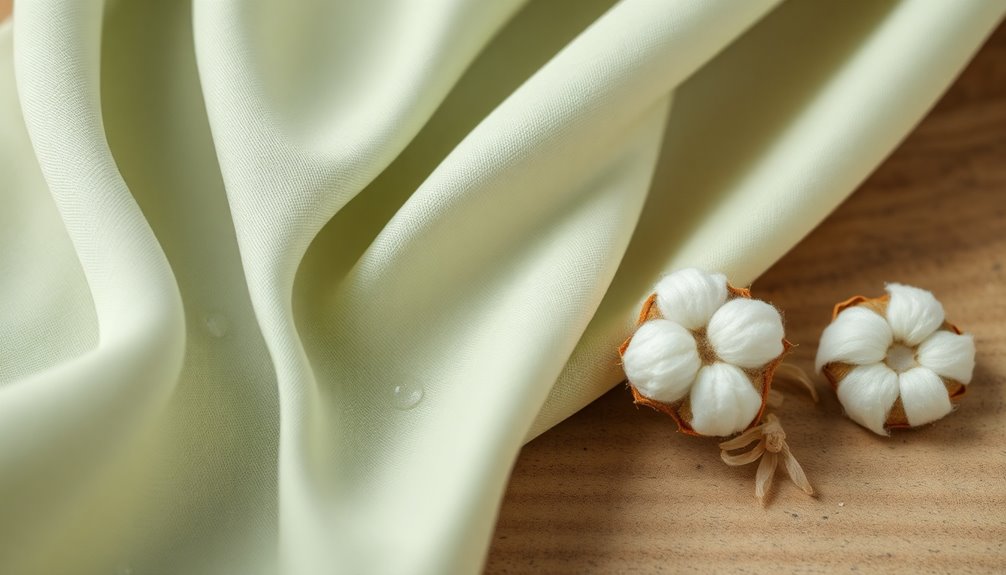
Cotton fabric is a popular natural fiber made from the soft, fluffy seed fibers of the cotton plant. Known for its softness and breathability, cotton is a versatile material used in clothing, bedding, and towels.
However, it's important to take into account its environmental impact. Producing a single cotton t-shirt requires about 2,700 liters of water, highlighting its high water consumption. Conventional cotton farming often relies on harmful pesticides and fertilizers, which can degrade soil and pollute the environment.
On the brighter side, organic cotton, grown without synthetic chemicals, uses considerably less water and is a biodegradable, sustainable option. Choosing organic cotton can help reduce the environmental footprint associated with this beloved fabric.
Sustainability Comparison: Lyocell vs. Cotton
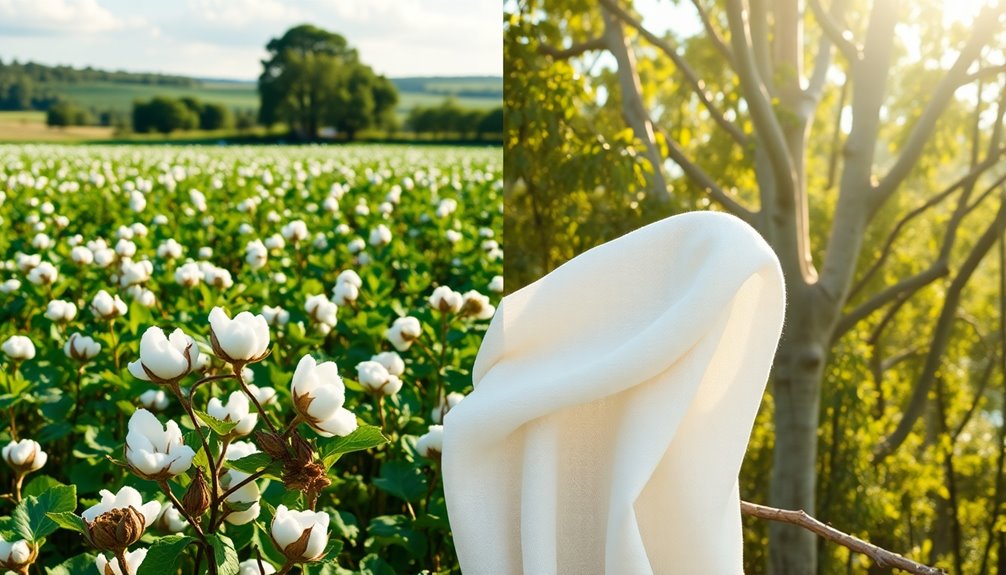
When considering sustainable fabric options, the differences between Lyocell and cotton become evident.
Here's what you need to know about their sustainability:
- Production Process: Lyocell uses a closed-loop system, recycling 99% of its chemicals, while cotton relies on pesticides and synthetic fertilizers.
- Water Usage: Cotton requires around 2,700 liters of water for a single t-shirt, making Lyocell a better choice for water conservation.
- Energy Efficiency: Lyocell's production is more energy-efficient than cotton, leading to a lower carbon footprint.
- Biodegradability: Both fabrics are biodegradable, but Lyocell breaks down without toxic residues, enhancing its eco-friendliness.
While organic cotton is more sustainable than conventional cotton, Lyocell generally stands out as the more environmentally friendly option.
Water Usage: A Closer Look
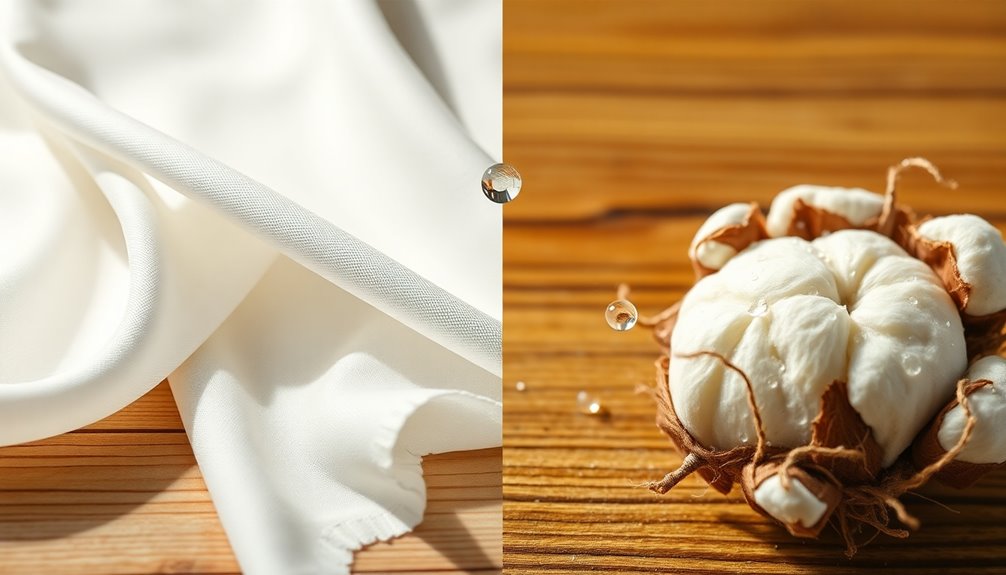
Water plays an essential role in fabric production, and the comparison between Lyocell and cotton highlights notable differences in their water usage.
Cotton production is notoriously water-intensive, requiring about 2,700 liters to make a single t-shirt. In contrast, Lyocell's efficient manufacturing process uses considerably less water. Its closed-loop system allows for recycling 99% of the water, making it a standout eco-friendly option.
While organic cotton farming reduces water consumption remarkably—91% less blue water and 62% less grey water—it still doesn't match Lyocell's conservation benefits.
Chemical Usage and Environmental Impact
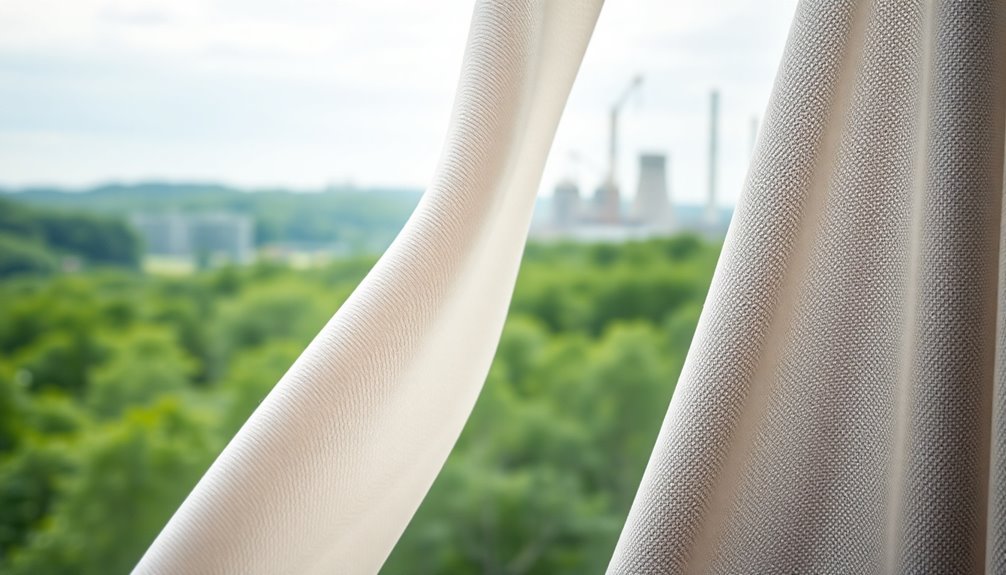
When you compare Lyocell and cotton, the difference in chemical usage becomes clear.
Cotton farming often involves harmful pesticides and a significant amount of water, which can degrade soil and pollute waterways.
In contrast, Lyocell's production method not only uses fewer chemicals but also breaks down more easily, making it a better choice for the environment.
Pesticides and Herbicides Impact
While conventional cotton farming heavily relies on pesticides and herbicides, Lyocell offers a cleaner alternative with its eco-friendly production process.
Here are some key points to reflect on:
- Conventional cotton uses about 16% of the world's insecticides, harming soil and water.
- Lyocell's closed-loop system recycles 99.5% of solvents, minimizing chemical waste.
- Organic cotton, grown without synthetic pesticides, promotes better soil health and uses 91% less blue water.
- The chemical usage in conventional cotton poses health risks for farmworkers, while Lyocell's non-toxic process reduces these dangers.
Water Consumption Comparison
The comparison between Lyocell and cotton extends beyond pesticide use to highlight considerable differences in water consumption. Cotton production is highly water-intensive, requiring around 2,700 liters to produce just one t-shirt. In contrast, Lyocell uses considerably less water due to its efficient manufacturing process and relies on renewable resources like eucalyptus trees. Even organic cotton, while more sustainable, requires substantial water compared to Lyocell.
| Fabric Type | Water Consumption |
|---|---|
| Conventional Cotton | 2,700 liters per t-shirt |
| Organic Cotton | Substantial water required |
| Lyocell | Considerably less water |
The environmental impact of Lyocell is lower, making it a more sustainable fiber choice that's biodegradable and compostable.
Biodegradability of Fabrics
Although both Lyocell and cotton can biodegrade, their environmental impacts differ considerably.
When considering fabric options, keep the following points in mind:
- Biodegradability: Lyocell is 100% biodegradable and compostable, breaking down without toxic residues, while cotton takes longer to decompose.
- Chemical Usage: Lyocell's closed-loop production process reuses 99.5% of solvents, considerably reducing chemical usage compared to conventional cotton farming, which often uses pesticides.
- Water Usage: Producing Lyocell requires much less water than cotton, which needs about 2,700 liters for a single t-shirt.
- Sustainability: Lyocell has a lower carbon footprint and overall environmental impact, making it a more sustainable choice than conventional cotton, even with organic options available.
Comfort and Wearability: Lyocell vs. Cotton

When it comes to comfort and wearability, you'll notice that Lyocell offers a silky texture that feels smoother against your skin compared to cotton.
Not only does it excel in softness, but Lyocell also manages moisture effectively, helping to keep you dry and comfortable throughout the day.
While cotton can be cozy, its comfort level often depends on quality, making Lyocell a consistently luxurious choice.
Softness and Texture
Softness is a key factor in choosing fabrics for comfort and wearability, and here, Lyocell truly excels. Its silky texture offers a luxurious feel that's gentle on the skin, especially for those with sensitivities.
While cotton can be comfortable, its softness often varies based on quality.
Consider these benefits of Lyocell:
- Luxurious feel: The smooth texture elevates comfort.
- Hypoallergenic: Reduces irritation, perfect for sensitive skin.
- Breathable fabric: Keeps you cool and comfortable.
- Durability: Less prone to pilling, ensuring long-lasting wear.
With its moisture-wicking properties and superior softness, Lyocell stands out as the go-to fabric for your comfort needs.
Moisture Management Properties
Comfort extends beyond softness, and moisture management plays a significant role in how a fabric feels against your skin.
Lyocell's moisture management properties shine, as it effectively draws moisture away from the skin. It's absorbent than cotton, boasting up to 50% better moisture absorption, making it perfect for activewear and warm climates.
Its breathable nature enhances comfort by keeping you dry and cool, unlike cotton, which can feel damp and uncomfortable during intense activities.
In addition, Lyocell reduces bacteria growth and odor retention, allowing for longer wear between washes. In contrast, cotton tends to trap odors, leading to a less pleasant experience.
Choosing Lyocell means enjoying superior comfort and freshness throughout your day. Additionally, maintaining proper hydration is essential for overall physical health, as it can affect how your skin reacts to different fabrics.
Softness and Breathability Comparison
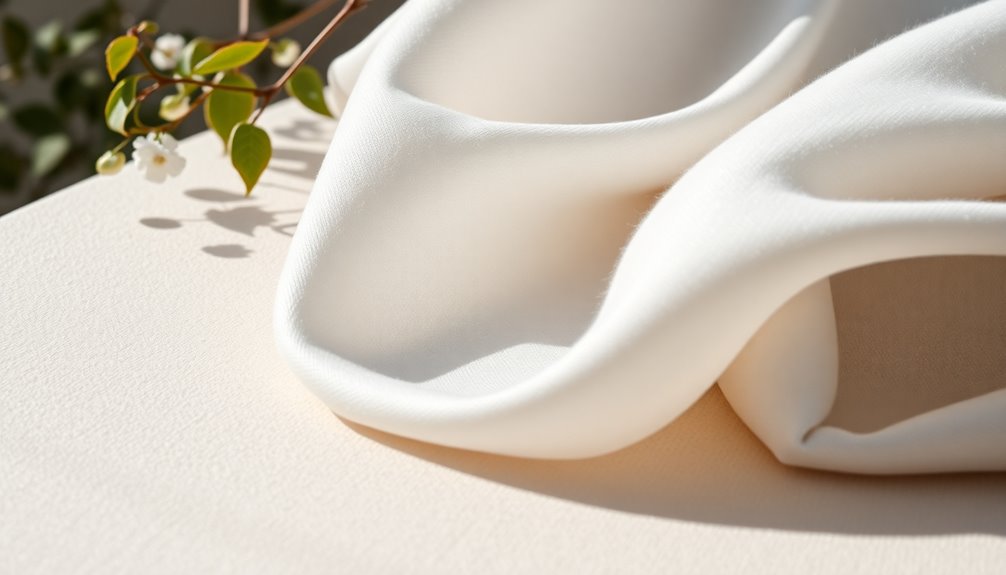
Choosing between Lyocell and cotton often comes down to how they feel against your skin and how well they breathe.
Here's a quick comparison to help you decide:
- Softness: Lyocell has a silky texture, offering a softer feel than cotton, especially if the cotton isn't high-quality.
- Breathability: Both fabrics are breathable, but Lyocell excels in moisture-wicking, keeping you comfortable and regulating body temperature.
- Sensitive Skin: Lyocell's properties make it ideal for sensitive skin, reducing irritation and discomfort.
- Pilling: Unlike cotton, Lyocell resists pilling, maintaining its softness over time, which adds to its overall durability and comfort.
Durability and Care Requirements
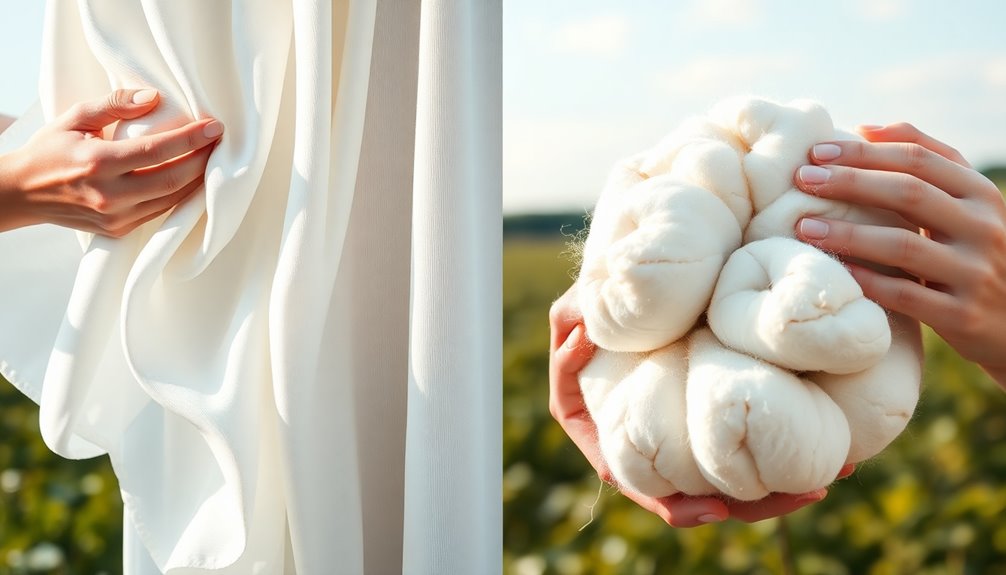
When it comes to durability and care, Lyocell typically outperforms cotton. You'll find that Lyocell exhibits less pilling and maintains its integrity over time, resulting in a longer lifespan for your garments and bedding.
While high-quality cotton can be durable, it's more susceptible to wear and tear, especially if not treated properly.
For care instructions, Lyocell requires gentle handling, often needing cold water hand washing and air drying to prevent damage.
In contrast, cotton can handle higher washing temperatures and dryer use, but it may experience significant wrinkling, requiring regular ironing.
Additionally, Lyocell may only shrink about 3% in its first wash, while cotton can face more severe shrinkage and wear over time.
Choosing the Right Fabric for Your Needs

What fabric best suits your lifestyle and needs? When choosing between Lyocell and cotton, consider these factors:
- Skin Sensitivity: If you have sensitive skin, Lyocell is hypoallergenic and moisture-wicking, reducing irritation compared to cotton.
- Sustainability: Lyocell is more eco-friendly, using considerably less water and produced through a closed-loop process that recycles chemicals.
- Durability: High-quality Lyocell is more durable and less prone to pilling, offering better long-term value than cotton.
- Biodegradability: Both fabrics are biodegradable, but Lyocell breaks down more easily without toxic residues, aligning with sustainable practices.
Final Thoughts on Lyocell and Cotton
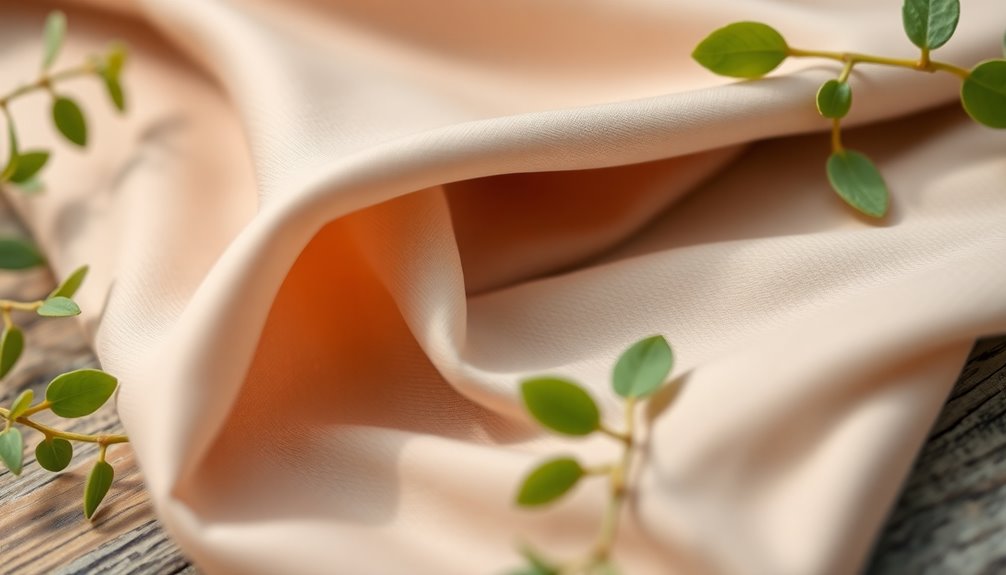
In the quest for the perfect fabric, understanding the nuances between Lyocell and cotton is essential. If you prioritize sustainability, Lyocell stands out as an environmentally friendly option due to its closed-loop production process, recycling 99% of chemicals.
While both fabrics are biodegradable, Lyocell breaks down more easily and without toxic residues. For those with sensitive skin, Lyocell's hypoallergenic and moisture-wicking properties make it a skin-friendly choice.
Cotton might be more affordable, but its durability and long-term investment potential often justify Lyocell's higher cost.
Ultimately, the decision between Lyocell and cotton hinges on your values—whether you prioritize eco-consciousness, comfort, or budget. Choosing wisely can benefit both your skin and the planet.
Frequently Asked Questions
Is Lyocell Healthier Than Cotton?
Yes, Lyocell is generally healthier than cotton.
It's made from natural wood pulp and processed in a way that minimizes harmful chemicals, making it gentle on sensitive skin. You'll notice its moisture-wicking properties help keep you dry and comfortable, reducing irritation.
Plus, Lyocell is biodegradable, breaking down more easily than cotton, which contributes to a healthier planet.
With its durability, it maintains quality longer, providing a better choice for your wardrobe.
What Is the Healthiest Fabric for Your Skin?
When you're choosing the healthiest fabric for your skin, consider options like Lyocell and organic cotton.
Lyocell's hypoallergenic and moisture-wicking properties help regulate your body temperature and reduce irritation, making it great for sensitive skin.
On the other hand, organic cotton is soft and also hypoallergenic, but conventional cotton might irritate due to pesticide residues.
Ultimately, both fabrics are biodegradable, but Lyocell's smooth texture can offer added comfort and reduce chafing.
What Are the Disadvantages of Lyocell Fabric?
When considering Lyocell fabric, you might find some drawbacks lurking beneath its surface.
It can be pricier due to its complex manufacturing process, which might catch you off guard. Plus, its delicate fibers often require special care—think handwashing or low heat ironing—to keep it looking fresh.
And don't forget about potential shrinkage during the first wash, which can be a bit surprising.
Finally, limited availability could make it harder to find exactly what you need.
What Is the Best Fabric to Wear for the Environment?
When you're choosing the best fabric for the environment, consider options like Lyocell.
It's produced in a closed-loop process that recycles chemicals and uses far less water than traditional cotton.
Plus, Lyocell is biodegradable, reducing landfill waste.
While organic cotton is a better choice than conventional cotton, it still requires significant resources.
Conclusion
So, whether you're wrapping yourself in the eco-friendly embrace of lyocell or sticking with the classic comfort of cotton, it's all good, right? After all, what's a little water waste or chemical use when you're rocking that stylish tee? You've got choices, and they're all just a fabric away! Just remember, while you're saving the planet one shirt at a time, your skin deserves a little pampering too. Happy fabric shopping, eco-warrior!
